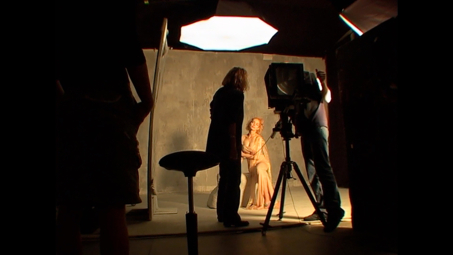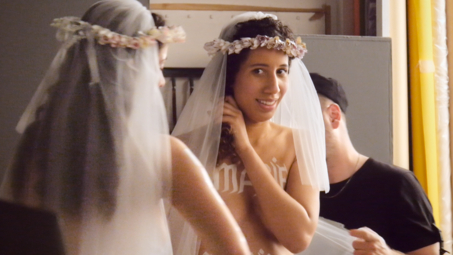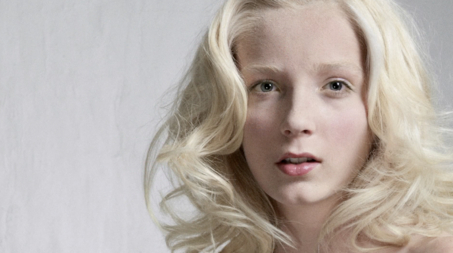Bettina Rheims (by Serge Bramly)
How to define what photography is, what distinguishes it from its elders, painting, engraving, drawing (to which it was for a long time subservient) or, if you'd rather, what constitutes this specific mode of representation? When Bettina Rheims began her career in the late 1970s, only a small number of books were devoted to photography and the question remained embryonic, possibly unformulated. A few studies were beginning to surface, such as Susan Sontag's; Barthes had not yet published Camera Lucida; rare were the monographs that allowed us to tackle a coherent set of works. In a way it was a new age of pioneers, both for artists and for galleries, and the public and private collections that were gradually emerging.
In this relative desert, the catalogue of the Diane Arbus retrospective at MoMA (1972) was for Bettina a compass, a pillar of cloud. Through the relationship she maintained with her models, as well as through the aesthetics of her square, frontal images drawn with an erratic black margin, Arbus had changed the very perception of photography, its status, its prospects. A preface accompanied the works, which were constantly consulted. Arbus referred to photography in particular as "something very subtle and rather disturbing." Laconic though she was, this was an inspiring definition; perhaps there's never been one better. There Bettina found a filiation, a taking root, in other words a path to follow as shown by her first series: the acrobats and fairground strippers of Pigalle work on the margins of society, where the neutrality of a grey background breaks the codes of the documentary by exposing the rather disturbing subtlety of a reality formalized and above all laid bare. This problem of the margin (and the marginalized), where art meets social issues and personifies them with sovereign probity, continued to preoccupy Bettina thereafter. Her central "iconic" work (her glamorous icon factory: Female Trouble, More Trouble, Heroines, Just Like a Woman, etc.) has thus always been doubled, always prolonged by an incessant peripheral exploration, where priority is given to nature of the subject, its very existence, whether it is her series on tranvestites, transgender people (Les Espionnes, Gender Studies), or those on the blind and, more recently, on Femen activists (Naked War), and on women sentenced to prison (Les Détenues).
There were other influences, of course. The history of art is like a family tree with many branches. Critics often quote Helmut Newton, friend and mentor, who said that only the pursuit of an obsession matters. We could mention other names; I'd like to stick to two, whose decisive influence extended almost secretly throughout this pivotal period.
Hugues Autexier and François Braunschweig, better known under the composite name of Texbraun, were not content just to offer their gallery's picture rails to Bettina's first strippers. Pioneers among pioneers, these two dealers (they took exception to "gallery owners") possessed, in photographic terms, a "perfect eye", in the same way that we talk of "perfect pitch".in music. Archaeologists of the early 19th century (Le Gray, Nègre, Bayard), these discoverers showed as much curiosity for the singular and the unusual (the "rather disturbing") as intransigeance towards print quality, the rendering (the material, the nebula of semitones: the "very subtle"). You had to show your credentials to gain access to their lair in the flea market, as later to their gallery on rue Mazarine. A perpetual ironic smile played on Hugues' lips in particular: modesty, no doubt, but it intimidated more than invited. Entering their very closed circle, it must be said, amounted to penetrating photography's holy of holies. In their office, if you were lucky enough for them to open their drawers to you, they wouldn't explain: they were content to show; they were showmen (the silhouette of a rider emerging from the dawn mist at Châlons camp, a convulsed body on a metal bed at La Salpêtrière, an anonymous tree whose trunk and branches seemed as old the pyramids, etc.), and that in itself was quite a lesson.
Representing consists in recording and then reporting. Whether during the shoot or when restoring it in the darkroom under the enlarger, Bettina never forgot the lessons of the highly demanding Texbraun, who passed too soon. Inside the camera's viewfinder as on the limited surface of the snapshot, the smallest thing, the tiniest detail has a place, a role, a crucial importance, like cogs in a clockwork mechanism. So because of the restrictions imposed by the frame, as space is lacking, the appearance of an incongruous element (a background shimmer, a shiny eye, a half-sketched gesture, a shadow's lack of sharpness) can make all the difference. I could evoke the imaginative power of the eye, the force of the fiction, even the unprecedented complexity of the story, paths that Bettina explored on multiples occasions, working on real scenarios (Chambre close, I.N.R.I., Rose, c’est Paris), but whatever its value, its scope, its novelty, the motive (the anecdote) in photography is priceless, unless it touches the hottest news, and only by the treatment that we give it.
Bettina built her method on this axiom. Trained from a young age in the ideal forms of classical art by a father who was both auctioneer and collector, she first constructed a rigorous system, a store of both scenery and props, so that when in session in this closed theatre, the flowers of fortune (Man Ray called himself a "fautographe") so specific to photography may bloom. In other words, she orchestrates, staging within a strict framework, engaging freely with her models in a conversation where the business of seduction competes with intimate secrets, and thereby leaves the field open to improvisation, to surprise gifts, to random miracles: to the poetics of disagreement. She adds nothing; rather she subtracts, endlessly purifying. She herself talks of twisting the order she defined in advance. And it's from this torque, from this disturbance that the right photo is born, it being understood that the right photo is first of all the one that has never been taken, according to Alexey Brodovitch, Arbus' teacher at the New School for Social Research. — "Amaze me!" he would repeat to his students. In a certain way, you might say, by upsetting the limits she previously set, Bettina is similarly seeking to amaze herself.
As disruptive as it is, the subtle is no friend to the spectacular. Even in her advertising and fashion commissions, the subtle is born in Bettina from a rendering of the real that makes the material photographed (the skin, for example) more present, more alive, more sensitive, more perceptible in the end than In reality the eye can see. — How many hours were spent lowering the magenta by a quarter-point and boosting the density of the yellow slightly to obtain the desired flesh tone!
Serge Bramly, May 2021
Translated from French by Henry Moon
Cover Photo : L'oeil de Justice (Justice Eye) ©Bettina Rheims




